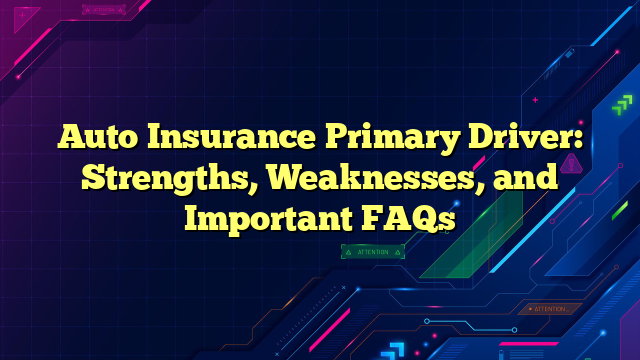Introduction
Hello PortalSindo Friend,
When it comes to purchasing auto insurance, one important factor to consider is who the primary driver of the vehicle will be. The primary driver is the person who will be using the vehicle most frequently and is typically the person who owns the vehicle. In this article, we will discuss the strengths and weaknesses of having a primary driver on your auto insurance policy and answer some important FAQs.
What is a Primary Driver?
A primary driver is the person who will be using the vehicle most frequently and is typically the person who owns the vehicle. When you purchase auto insurance, you will be asked to provide information about the primary driver of the vehicle. This information is used to determine the cost of your insurance premium.
Strengths of Having a Primary Driver on Your Auto Insurance Policy
1. Reduced Insurance Premiums: When you have a primary driver on your auto insurance policy, insurance companies are more likely to offer you lower premiums. This is because insurers view having a primary driver as a sign of stability and responsibility.
2. Easier Claims Process: When you have a primary driver listed on your insurance policy, the claims process is typically easier. This is because the insurer already has all the necessary information about the driver, making it easier to process any claims that may arise.
3. Increased Coverage: Having a primary driver on your auto insurance policy can also increase your coverage. This is because insurers view having a primary driver as a sign of stability and responsibility, making them more likely to offer you better coverage options.
4. Legal Compliance: In many states, having a primary driver listed on your auto insurance policy is a legal requirement. This is because the primary driver is typically the person who is responsible for any accidents that occur while using the vehicle.
5. Personalized Coverage: When you have a primary driver on your auto insurance policy, you can tailor your coverage to fit their specific needs. This can include adding additional coverage options, such as collision or comprehensive coverage.
6. Peace of Mind: Having a primary driver on your auto insurance policy can give you peace of mind knowing that you are fully covered in the event of an accident or other unexpected event.
7. Build Trust with Insurer: Having a primary driver on your auto insurance policy can help you build trust with your insurer. This can lead to better rates and coverage options in the future.
Weaknesses of Having a Primary Driver on Your Auto Insurance Policy
1. Limited Flexibility: When you have a primary driver on your auto insurance policy, it can limit your flexibility in terms of who can use the vehicle. This is because only the primary driver is covered under the policy, and any other drivers may not be covered in the event of an accident.
2. Higher Premiums for Additional Drivers: If you want to add additional drivers to your auto insurance policy, it can result in higher premiums. This is because insurers view additional drivers as a higher risk.
3. Higher Premiums for High-Risk Drivers: If your primary driver is considered a high-risk driver, it can result in higher premiums for your auto insurance policy.
4. Limited Coverage for Non-Primary Drivers: If you have non-primary drivers listed on your auto insurance policy, they may not be covered in the event of an accident. This is because the policy is designed to cover the primary driver, not additional drivers.
5. Limited Coverage for Business Use: If you use your vehicle for business purposes, having a primary driver on your auto insurance policy may not provide enough coverage.
6. Limited Coverage for Rental Vehicles: If you rent a vehicle, your primary driver may not be covered under your auto insurance policy.
7. Higher Premiums for Commercial Use: If you use your vehicle for commercial purposes, having a primary driver on your auto insurance policy may result in higher premiums.
FAQs
| Question | Answer |
|---|---|
| 1. What is a primary driver? | A primary driver is the person who will be using the vehicle most frequently and is typically the person who owns the vehicle. |
| 2. Why is having a primary driver on your auto insurance policy important? | Having a primary driver on your auto insurance policy can lead to lower premiums, easier claims processing, increased coverage, legal compliance, personalized coverage, peace of mind, and building trust with your insurer. |
| 3. Can you have multiple primary drivers on your auto insurance policy? | No, you can only have one primary driver listed on your auto insurance policy. |
| 4. Can you add additional drivers to your auto insurance policy? | Yes, you can add additional drivers to your auto insurance policy, but it may result in higher premiums. |
| 5. What happens if a non-primary driver gets into an accident while using the vehicle? | If a non-primary driver gets into an accident while using the vehicle, they may not be covered under the auto insurance policy. |
| 6. How does having a primary driver on your auto insurance policy affect coverage for business use? | Having a primary driver on your auto insurance policy may not provide enough coverage for business use of the vehicle. |
| 7. Does having a primary driver on your auto insurance policy affect coverage for rental vehicles? | Yes, your primary driver may not be covered under your auto insurance policy for rental vehicles. |
| 8. Why do insurers view having a primary driver as a sign of stability and responsibility? | Insurers view having a primary driver as a sign of stability and responsibility because it indicates that the vehicle is being used in a consistent and responsible manner. |
| 9. How can having a primary driver on your auto insurance policy help you build trust with your insurer? | Having a primary driver on your auto insurance policy can help you build trust with your insurer by demonstrating that you are a responsible and consistent driver. |
| 10. How does having a primary driver on your auto insurance policy affect premiums for high-risk drivers? | Having a primary driver who is considered a high-risk driver may result in higher premiums for your auto insurance policy. |
| 11. How can you tailor your coverage to fit your primary driver’s specific needs? | You can tailor your coverage to fit your primary driver’s specific needs by adding additional coverage options, such as collision or comprehensive coverage. |
| 12. What happens if your primary driver changes? | If your primary driver changes, you will need to update your auto insurance policy to reflect the new primary driver. |
| 13. Can you remove the primary driver from your auto insurance policy? | Yes, you can remove the primary driver from your auto insurance policy, but it may result in higher premiums or limited coverage. |
Conclusion
In conclusion, having a primary driver on your auto insurance policy can have its strengths and weaknesses. It can lead to lower premiums, easier claims processing, increased coverage, legal compliance, personalized coverage, peace of mind, and building trust with your insurer. However, it can also result in limited flexibility, higher premiums for additional drivers or high-risk drivers, limited coverage for non-primary drivers or business use, and higher premiums for commercial use. It is important to weigh these factors carefully when deciding whether or not to have a primary driver on your auto insurance policy. We hope this article has provided you with valuable information and answered some important FAQs.
Thank you for reading, and don’t hesitate to take action by contacting your insurance provider to discuss your options.
Disclaimer
The information provided in this article is for general informational purposes only and should not be construed as professional advice. You should always consult with your insurance provider or a licensed insurance agent to discuss your specific needs and coverage options. We do not endorse any particular insurance provider or policy. The use of any information provided in this article is solely at your own risk.






